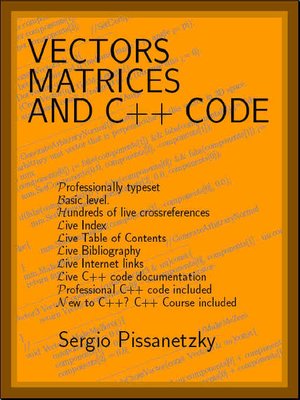Vectors, Matrices and C++ Code
ebook ∣ The Object Foundation of Rigid Body Mechanics
By Sergio Pissanetzky

Sign up to save your library
With an OverDrive account, you can save your favorite libraries for at-a-glance information about availability. Find out more about OverDrive accounts.
Find this title in Libby, the library reading app by OverDrive.



Search for a digital library with this title
Title found at these libraries:
| Library Name | Distance |
|---|---|
| Loading... |
Presented here is an integrated approach - perhaps the first in its class - of College vector and matrix Algebra with the object-oriented C++ code that implements the vectors and matrix objects and brings them to life.
Objects have existed in Science for centuries. An object associates properties and behavior in a single, nseparable entity, an abstraction consisting of properties and a description of their behavior. More recently, objects were introduced in Computation, and object-oriented languages were created. Yet, the concept of object is not routinely used when teaching Science, and the idea that objects can come alive in a computer remains unexploited.
This book is intended to provide an integrated approach of College vector and matrix Algebra with object-oriented concepts and the actual code implementing them. The source code is included by download, and readers are free to use it for their own work provided proper credit is always given. Coding is about empowerment, and we want to empower the reader with the ability to create his/her own live objects and cause them to act their parts. This is the first volume of what we expect to be a series covering, approximately, the following topics of Mathematics and Physics: Coordinate Transformations, Graphs, Sparse Matrices, Linear Equations, the Dynamics of Multibody Systems, and the intelligent control of Articulated
Multibody Robotic Structures. Other titles may be added as needed. All of them, of course, with the corresponding source code included.
This product is both a textbook and a software release. The book can be regarded as very complete software documentation, consisting not only of the description of classes, attributes and methods, but also of the mathematical background that supports the code. Just as
business code is best understood by those with a background in that business, scientific code is best understood by those with a background in mathematics.
The code presented here is in no way new. Its roots date back more than 30 years. It evolved from its original non-object-oriented Fortran versions to its current fully object-oriented versions in C++. It grew as it evolved, becoming part of several well known professional scientific programs such as Kubik, Magnus, Epilog,
PhysicSolver, and others, and it served engineering applications such as the design of Particle Accelerators, Magnetic Resonance Imaging systems, thermal systems for nuclear reactors, and many others. It also served the teaching of Science.
To understand this book you will need a basic knowledge of Mathematical notation, Algebra and Trigonometry. If you are not familiar with C++ or object-oriented methodology, you can learn it right here, because a basic course on C++ and computational objects is included. It is not a regular course, because as you learn you can refer directly to the
included professional code, something not usually vailable in a traditional course. If you are not interested in learning vectors and matrices but only in using the code,
you can still do so. The code documentation has links to the underlying mathematical concepts, or it can be understood even if you ignore them. You should read this book if you are a developer and you need a background in vector or matrix algebra, or you are a science student and you need to learn C++, or you are a scientist and you need to write advanced code but don't want to waste time developing the basics, or you need ready-to-use C++ source code for your science project.







